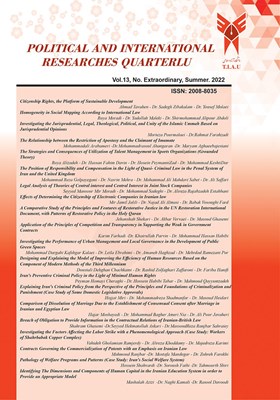Pathology of Welfare Programs and Patterns (Case Study: Iran's Social Welfare System)
Subject Areas : Political and International Researches Quarterly
Hossein Shahvardi
1
,
Soroush Fathi
2
,
Tahmourth Shiri
3
![]()
1 - PhD student in development sociology, Tehran West Branch, Islamic Azad University, Tehran, Iran
2 - Associate Professor of Sociology, West Tehran Branch, Islamic Azad University, Tehran, Iran: Corresponding Author, fathi.soroush@gmail.com
3 - Associate Professor of Sociology, Central Tehran Branch, Islamic Azad University, Tehran, Iran
Keywords: Models, pathology, elderly, Welfare Programs, Social Security System,
Abstract :
Due to the beginning of the phenomenon of aging in the world, most countries are continuously monitoring the needs, the state of economic well-being, security, and social well-being of the elderly and identifying and ensuring their physical and mental health and their caregivers. Programs such as monitoring indicators are being carried out. Aging and active aging can be evaluated from the same dimension. Iran started policy making in this area in the 80s. Since then the discussion of aging has become one of the serious topics of demographic policy in Iran. The examination of the situation of aging in Iran shows that aging is far from international standards and in some indicators, this gap is so large that it can be called a gap. The reports of the organizations responsible for the field of aging also indicate failure in some indicators. Analysis of the situation generally suggests the lack of coordination among the responsible organizations and the lack of coherence in the programs. Therefore, this article aims to examine the harms of the programs and models of the organizations in charge of aging in Iran. Specifically, it seeks to identify the harms of the old age programs of the social welfare system.
_||_


